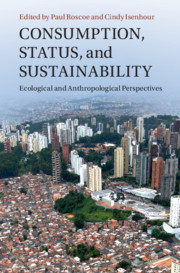Book contents
- Consumption, Status, and Sustainability
- New Directions In Sustainability And Society
- Consumption, Status, and Sustainability
- Copyright page
- Contents
- Figures
- Tables
- Contributors
- Preface
- 1 Standing Out, Fitting In, and the Consumption of the World
- Part I Status Competition and Hierarchy in Human Societies
- Part II Variability in Status Consumption
- 4 Status Competition in the Ancient Past?
- 5 Leadership, the Funding of Power, and Sustainability in the Prehispanic Mesoamerican World
- Part III Continuity and Discontinuity
- Part IV Bending the Curve
- Index
- References
4 - Status Competition in the Ancient Past?
Tracing Antecedence in the Mimbres Region of the US Southwest
from Part II - Variability in Status Consumption
Published online by Cambridge University Press: 30 July 2021
- Consumption, Status, and Sustainability
- New Directions In Sustainability And Society
- Consumption, Status, and Sustainability
- Copyright page
- Contents
- Figures
- Tables
- Contributors
- Preface
- 1 Standing Out, Fitting In, and the Consumption of the World
- Part I Status Competition and Hierarchy in Human Societies
- Part II Variability in Status Consumption
- 4 Status Competition in the Ancient Past?
- 5 Leadership, the Funding of Power, and Sustainability in the Prehispanic Mesoamerican World
- Part III Continuity and Discontinuity
- Part IV Bending the Curve
- Index
- References
Summary
Evidence of status competition in the US Southwest is subtle and often devoid of material excess, pushing archaeologists to challenge the ways in which they think about and search for social differences. Using data from the large Mimbres site of Galaz, we focus on the concept of antecedence, a form of social status derived from being viewed as a first-comer or the descendant of first-comers. Our results suggest that while archaeology can offer insights into status and consumption in the ancient past, broadening our views of what is possible, we must be cautious in applying those insights directly to the contemporary world.
- Type
- Chapter
- Information
- Consumption, Status, and SustainabilityEcological and Anthropological Perspectives, pp. 87 - 113Publisher: Cambridge University PressPrint publication year: 2021
References
- 1
- Cited by

